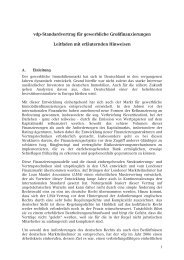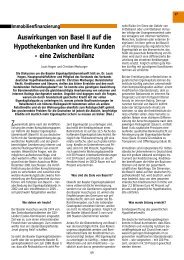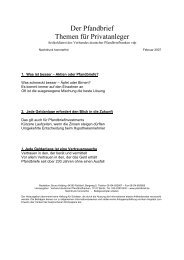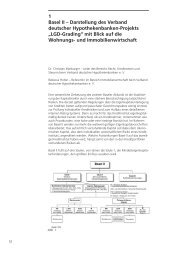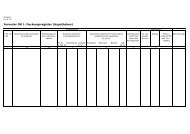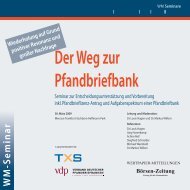The Pfandbrief 2011 | 2012
The Pfandbrief 2011 | 2012
The Pfandbrief 2011 | 2012
Create successful ePaper yourself
Turn your PDF publications into a flip-book with our unique Google optimized e-Paper software.
<strong>The</strong> Methodologies of the Rating Agencies<br />
Fitch Ratings’ Covered Bonds (CBs) Rating Methodology | Fitch Ratings methodology mainly addresses<br />
the probability of default (PD) of the debt but also incorporates an element of post-default recovery expectation.<br />
Fitch Ratings defines “default” as failure to make full and timely payments of interest and/or principal<br />
on payments due under the instruments.<br />
<strong>The</strong> covered bonds rating methodology has been applied since 2007 and covers the following analytical steps:<br />
— Discontinuity: Analyses the risk that payments due on the CB are not met in a timely manner as a consequence<br />
of the insolvency of the issuer. <strong>The</strong> agency’s view about the likelihood of such an event is<br />
expressed by the discontinuity factor (D-Factor). <strong>The</strong> Fitch Discontinuity Factor is a percentage between<br />
0% (perfect continuity of payments) and 100% (concomitant default of the issuer and the CB).<br />
— Cash Flow Modelling: Analyses the cash flows in combination with the sustainability of the assets provided<br />
as collateral to investors. In doing so, Fitch also takes into account the available or committed overcollateralisation.<br />
Assuming the issuer defaults, Fitch tests whether cash flows from the cover assets are<br />
sufficient to meet the payments due under the CB.<br />
— Recoveries given Default: After having determined the maximum rating a CB can reach on a probability<br />
of default basis (PD rating), Fitch additionally takes into account expected recoveries in its simulation<br />
runs. <strong>The</strong> rating scenarios tested go beyond the one corresponding to the PD rating level. Depending on<br />
the expected recoveries the rating of the CB can be lifted by two (or three) notches above the PD rating,<br />
subject to whether the PD rating is in the investment grade (‘BBB-’ and above) range or below.<br />
160<br />
As such, the analysis is split into two parts: On the one hand the D-Factor considers the systemic and issuer<br />
specific elements, while on the other hand a quantitative risk analysis is conducted. <strong>The</strong> D-Factor is computed<br />
as a weighted average score of the following four components:<br />
— Asset Segregation 45%<br />
— Liquidity Gaps 35%<br />
— Alternative Management 15%<br />
— Covered Bonds Oversight 5%<br />
Additionally the D-Factor can be adjusted for counterparty risks dependent on the sensitivity of the investors<br />
to these risks. <strong>The</strong> rating-dependent stress scenarios used in Fitch Ratings’ quantitative analysis assess<br />
whether the cover pool’s payments (including overcollateralisation) are sufficient to meet the scheduled payments<br />
to the CB holders. Important factors considered are the quality of the cover assets as well as interest,<br />
currency and maturity mismatches between assets and liabilities.<br />
Fitch Ratings’ covered bond methodology is consistently applied since 2007 and has been partially adjusted at<br />
times to reflect market developments. In 2010 / <strong>2011</strong> the following updates were implemented:<br />
— Counterparty Risks: In March <strong>2011</strong> Fitch published its covered bond specific counterparty criteria. This<br />
criteria, inter alia, describes the analysis of payment interruption risks potentially occurring after the issuer’s<br />
insolvency. For a full mitigation of these risks Fitch expects a reserve to cover at a minimum the amount of<br />
expected covered bond interest payments due over the next three months on a rolling basis. Fitch will also<br />
assess the collateralisation of derivatives taking the rating of the issuer into account and the replacement<br />
prospects. For derivatives with internal counterparties Fitch assesses the replacement prospect more critically.<br />
If the counterparty risks are not fully mitigated Fitch will assume a higher probability of default following an<br />
issuer’s default expressed through an increased D-Factor.<br />
— Analysis of commercial real estate: In January 2010 Fitch placed nine covered bond programmes with<br />
a significant amount of commercial real estate exposure in their cover pools and limited data availability<br />
for these assets on Rating Watch Negative (RWN). In the meantime their RWN were resolved for seven programmes.<br />
Following the more detailed pool analysis for all of these programmes the OC supporting the ratings<br />
has increased.<br />
Analytical Contacts:<br />
Rebecca Holter, Director, Covered Bonds CEE (rebecca.holter@fitchratings.com, Tel. +49 69 7680 76 261)<br />
Susanne Matern, Senior Director, Covered Bonds CEE (susanne.matern@fitchratings.com, Tel. +49 69 7680 76 237)<br />
Business & Relationship Development Contact:<br />
Andreas Wagenknecht, Director, (andreas.wagenknecht@fitchratings.com, Tel. +49 69 7680 76 235)




